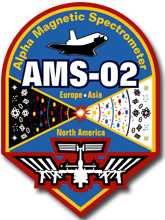|
 The Alpha Magnetic Spectrometer
AMS
is a state-of-the-art particle physics
detector containing a large permanent magnet, a silicon Tracker, two scintillator systems
and associated electronics and support structures. The instrument was designed,
constructed, and tested by an international team organized under DOE and NASA.
The science objective of AMS project is to advance knowledge of the universe
and to improve the understanding of the origin of universe.
Specifically, the scientific objectives of the AMS is to search for cosmic ray of
antimatter (i.e. anti-helium and heavier anti-elements) and the dark matter.
The Alpha Magnetic Spectrometer
AMS
is a state-of-the-art particle physics
detector containing a large permanent magnet, a silicon Tracker, two scintillator systems
and associated electronics and support structures. The instrument was designed,
constructed, and tested by an international team organized under DOE and NASA.
The science objective of AMS project is to advance knowledge of the universe
and to improve the understanding of the origin of universe.
Specifically, the scientific objectives of the AMS is to search for cosmic ray of
antimatter (i.e. anti-helium and heavier anti-elements) and the dark matter.
The international partners of AMS are from Finland, France, Germany, Italy, Portugal,
P.R.China, R.o.China, Russia, Spain, Switzerland, The Netherlands, United Kingdom
and USA. Finland has major responsibility for the design and production of the AMS
ground system. In addition, the laboratory participates in the production of the
particle detection system called Tracker.
On the first flight (test flight) June 1998 the AMS instrument was installed
into the Shuttle (
Discovery,
OV-103) cargo bay and the effective data taking time was approximately 110 hours during the 11 days
STS-91
mission.
For the second flight AMS was enhanced according to experience gained from the first flight.
AMS-02 was launched on May 16, 2011 with
Space Shuttle Endeavour (OV-105) flight
STS-134 / ULF4 and installed on
the International Space Station
(NASA pages,
ESA pages)
for several years period.
AMS collaboration is led by Nobel-prize winner Dr. Samuel C. C. Ting.
|
|

